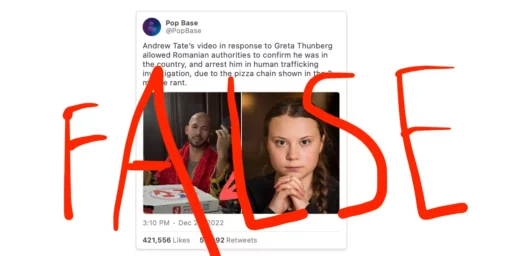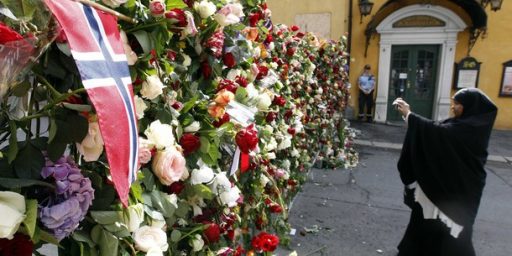Notorious Mass Murderer Charles Manson Dead at 83
Charles Manson, who led a cult-like "family" to a series of murders in 1969 and subsequently spent more than 40 years in prison, has died at the age of 83.
Charles Manson, who led a cult-like “family” to a series of murders in 1969 and subsequently spent more than 40 years in prison, has died at the age of 83:
Charles Manson, one of the most notorious murderers of the 20th century, who was very likely the most culturally persistent and perhaps also the most inscrutable, died on Sunday in Kern County, Calif. He was 83 and had been behind bars for most of his life.
He died of natural causes in a hospital, the California Department of Corrections and Rehabilitation said in a news release.
Mr. Manson was a semiliterate habitual criminal and failed musician before he came to irrevocable attention in the late 1960s as the wild-eyed leader of the Manson family, a murderous band of young drifters in California. Convicted of nine murders in all, Mr. Manson was known in particular for the seven brutal killings collectively called the Tate-LaBianca murders, committed by his followers on two consecutive August nights in 1969.
The most famous of the victims was Sharon Tate, an actress who was married to the film director Roman Polanski. Eight and a half months pregnant, she was killed with four other people at her Benedict Canyon home.
The Tate-LaBianca killings and the seven-month trial that followed were the subjects of fevered news coverage. To a frightened, mesmerized public, the murders, with their undercurrents of sex, drugs, rock ‘n’ roll and Satanism, seemed the depraved logical extension of the anti-establishment, do-your-own-thing ethos that helped define the ’60s.
Since then, the Manson family has occupied a dark, persistent place in American culture — and American commerce. It has inspired, among other things, pop songs, an opera, films, a host of internet fan sites, T-shirts, children’s wear and half the stage name of the rock musician Marilyn Manson.
It has also been the subject of many nonfiction books, most famously “Helter Skelter” (1974), by Vincent Bugliosi and Curt Gentry. Mr. Bugliosi was the lead prosecutor at the Tate-LaBianca trial.
The Manson family came to renewed attention in 2008, when officials in California, responding to long speculation that there were victims still unaccounted for, searched a stretch of desert in Death Valley. There, in a derelict place known as the Barker Ranch, Mr. Manson and his followers had lived for a time in the late ’60s. The search turned up no human remains.
It was a measure of Mr. Manson’s hold over his followers, mostly young women who had fled middle-class homes, that he was not physically present at the precise moment that any one of the Tate-LaBianca victims was killed. Yet his family swiftly murdered them on his orders, which, according to many later accounts, were meant to incite an apocalyptic race war that Mr. Manson called Helter Skelter. He took the name from the title of a Beatles song.
Throughout the decades since, Mr. Manson has remained an enigma. Was he a paranoid schizophrenic, as some observers have suggested? Was he a sociopath, devoid of human feeling? Was he a charismatic guru, as his followers once believed and his fans seemingly still do?
Or was he simply flotsam, a man whose life, The New York Times wrote in 1970, “stands as a monument to parental neglect and the failure of the public correctional system”?
No Name Maddox, as Mr. Manson was officially first known, was born on Nov. 12, 1934, to a 16-year-old unwed mother in Cincinnati. (Many accounts give the date erroneously as Nov. 11.) His mother, Kathleen Maddox, was often described as having been a prostitute. What is certain, according to Mr. Bugliosi’s book and other accounts, is that she was a heavy drinker who lived on the margins of society with a series of men.
Mr. Manson apparently never knew his biological father. His mother briefly married another man, William Manson, and gave her young son the name Charles Milles Manson.
Kathleen often disappeared for long periods — when Charles was 5, for instance, she was sent to prison for robbing a gas station — leaving him to bounce among relatives in Ohio, West Virginia and Kentucky. She was paroled when Charles was 8 and took him back, but kept him for only a few years.
From the age of 12 on, Charles was placed in a string of reform schools. At one institution, he held a razor to a boy’s throat and raped him.
Escaping often, he committed burglaries, auto thefts and armed robberies, landing in between juvenile detention centers and eventually federal reformatories. He was paroled from the last one at 19, in May 1954.
(…)
By March 1967, when Mr. Manson, then 32, was paroled from his latest prison stay, he had spent more than half his life in correctional facilities. On his release, he moved to the Bay Area and eventually settled in the Haight-Ashbury district of San Francisco, the nerve center of hippiedom, just in time for the Summer of Love.
There, espousing a philosophy that was an idiosyncratic mix of Scientology, hippie anti-authoritarianism, Beatles lyrics, the Book of Revelation and the writings of Hitler, he began to draw into his orbit the rootless young adherents who would become known as the Manson family.
Mr. Manson had learned to play the guitar in prison and hoped to make it as a singer-songwriter. His voice was once compared to that of the young Frankie Laine, a crooner who first came to prominence in the 1930s.
Mr. Manson’s lyrics, by contrast, were often about sex and death, but in the ’60s, that did not stand out very much. (Songs he wrote were later recorded by Guns N’ Roses and Marilyn Manson.) Once he was famous, Mr. Manson himself released several albums, including “LIE,” issued in 1970, and “Live at San Quentin,” issued in 2006.
With his followers — a loose, shifting band of a dozen or more — Mr. Manson left San Francisco for Los Angeles. They stayed awhile in the home of Dennis Wilson, the Beach Boys’ drummer. Mr. Manson hoped the association would help him land a recording contract, but none materialized. (The Beach Boys did later record a song, “Never Learn Not to Love,” that was based on one written by Mr. Manson, although Mr. Wilson, who sang it, gave it new lyrics and a new title — Mr. Manson had called it “Cease to Exist” — and took credit for writing it.)
The Manson family next moved to the Spahn Movie Ranch, a mock Old West town north of Los Angeles that was once a film set but had since fallen to ruins. The group later moved to Death Valley, eventually settling at the Barker Ranch.
The desert location would protect the family, Mr. Manson apparently thought, in the clash of the races that he believed was inevitable. He openly professed his hatred of black people, and he believed that when Helter Skelter came, blacks would annihilate whites. Then, unable to govern themselves, the blacks would turn for leadership to the Manson family, who would have ridden out the conflict in deep underground holes in the desert.
At some point, Mr. Manson seems to have decided to help Helter Skelter along. Late at night on Aug. 8, 1969, he dispatched four family members — Susan Atkins, Patricia Krenwinkel, Charles Watson and Linda Kasabian — to the Tate home in the Hollywood hills. Mr. Manson knew the house: Terry Melcher, a well-known record producer with whom he had dealt fruitlessly, had once lived there.
Shortly after midnight on Aug. 9, Ms. Atkins, Ms. Krenwinkel and Mr. Watson entered the house while Ms. Kasabian waited outside. Through a frenzied combination of shooting, stabbing, beating and hanging, they murdered Ms. Tate and four others in the house and on the grounds: Jay Sebring, a Hollywood hairdresser; Abigail Folger, an heiress to the Folger coffee fortune; Voytek (also spelled Wojciech) Frykowski, Ms. Folger’s boyfriend; and Steven Parent, an 18-year-old visitor. Ms. Tate’s husband, Mr. Polanski, was in London at the time.
Before leaving, Ms. Atkins scrawled the word “pig” in blood on the front door of the house; in Mr. Manson’s peculiar logic, the killings were supposed to look like the work of black militants.
The next night, Aug. 10, Mr. Manson and a half-dozen followers drove to a Los Angeles house he appeared to have selected at random. Inside, Mr. Manson tied up the residents — a wealthy grocer named Leno LaBianca and his wife, Rosemary — before leaving. After he was gone, several family members stabbed the couple to death. The phrases “Death to Pigs” and “Healter Skelter,” misspelled, were scrawled in blood at the scene.
The seven murders went unsolved for months. Then, in the autumn of 1969, the police closed in on the Manson family after Ms. Atkins, in jail on an unrelated murder charge, bragged to cellmates about the killings.
On June 15, 1970, Mr. Manson, Ms. Atkins, Ms. Krenwinkel and a fourth family member, Leslie Van Houten, went on trial for murder. Ms. Kasabian, who had been present on both nights but said she had not participated in the killings, became the prosecution’s star witness and was given immunity. Mr. Watson, who had fled to Texas, was tried and convicted separately.
During the trial, the bizarre became routine. On one occasion, Mr. Manson lunged at the judge with a pencil. On another, he punched his lawyer in open court. At one point, Mr. Manson appeared in court with an “X” carved into his forehead; his co-defendants quickly followed suit. (Mr. Manson later carved the X into a swastika, which remained flagrantly visible ever after.)
Outside the courthouse, a small flock of chanting family members kept vigil. One of them, Lynette Fromme, nicknamed Squeaky, would make headlines herself in 1975 when she tried to assassinate President Gerald R. Ford.
On Jan. 25, 1971, after nine days’ deliberation, the jury found Mr. Manson, Ms. Atkins and Ms. Krenwinkel guilty of seven counts of murder each. Ms. Van Houten, who had been present only at the LaBianca murders, was found guilty of two counts. All four were also convicted of conspiracy to commit murder.
On March 29, the jury voted to give all four defendants the death penalty. In 1972, after capital punishment was temporarily outlawed in California, their sentences were reduced to life in prison.
There’s not really any good that can be said about Manson, of course, and personally I’ve never quite understood the cultural fascination with a mass murdering cult leader who, among other things, inspired one woman to attempt to kill a President several years after he had been convicted of the crimes committed in 1969. He often reappeared in the public consciousness when his parole hearings came up, of course, and the television interviews that he gave revealed a man that was some bizarre combination of evil and insane. Whichever one is true, it was a good thing that he was behind bars and, quite honestly, it’s good thing that he’s dead.






To hell with him, literally. I’d rather think about Tate, who would be in her 70s now, and the baby she was about to have, who would be 48. Jay Sebring, Wojciech Frykowski, Abigail Folger, Steven Parent. Forget the murderers; remember the victims.
At least I’ve seen my last ‘will they parole Charles Manson?’ headline.
We could ask these scumbags.
‘Blood and Soil’: White Nationalists Chant Nazi Slogans at Tennessee Rally
Haaretz
I was thinking about writing an explanation about Manson as character and archetype but you know what? The piece of sh!t is dead, f-ck him. Rot on into obscurity, Charlie.
This summer I read Jeff Guinn’s Manson, a very detailed biography of the man. Guinn really cuts Manson down to size, and does a very good job of giving you a feel for the 1960’s and the west coast. From being a satanic fiend and mastermind, Guinn shows that Manson was really a pathetic loser whose cult was falling apart because he couldn’t keep his acolytes in line and he was fleeing from motorcycle gangs who wanted to kill him for debts and bad drug deals.
Really a good book: http://www.simonandschuster.ca/books/Manson/Jeff-Guinn/9781451645170
I would have liked him to live longer, and slowly fade more and more into obscurity. Maybe see a slight resurgence in notoriety when Taylor Swift or someone did a cover of the Beatles “Helter Skelter”
Or to have died earlier, roughly at the election of Obama, so he would think that the race war he wanted was forever out of reach. The rise of neonazis in America probably made him happy, and I would have liked to deny him that.
@Hal_10000: Too bad that Manson got a lot of publicity and attention all these years: a tragedy compounded. A relic from the ’60’s.
@Tyrell: Now… You could take it easy on that ‘relic of the 60’s’ business there buddy… Some of us are kinda proud of that title, ya know!